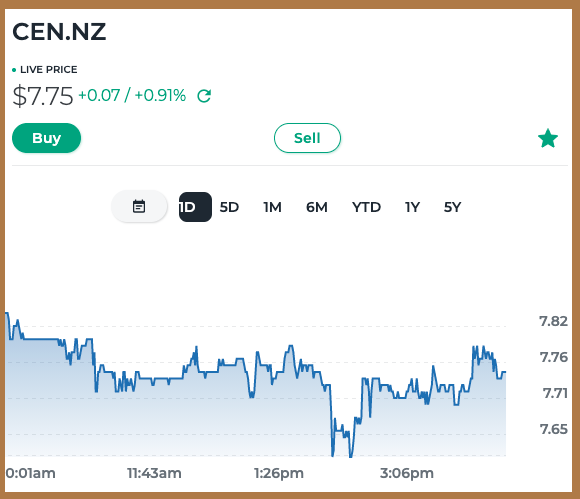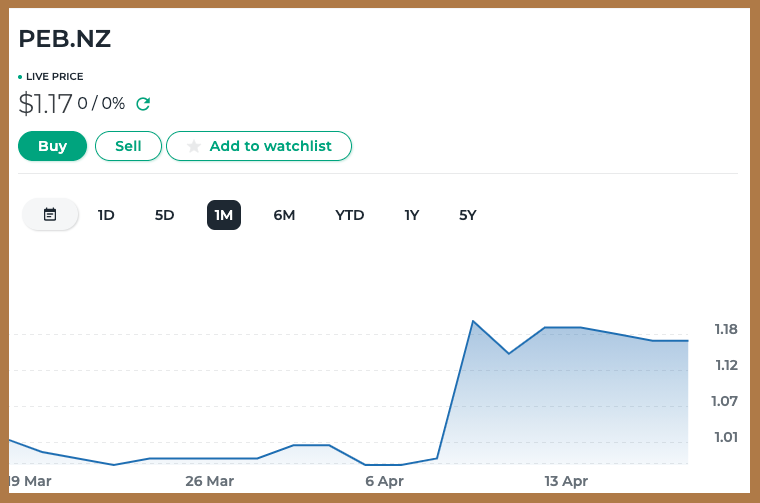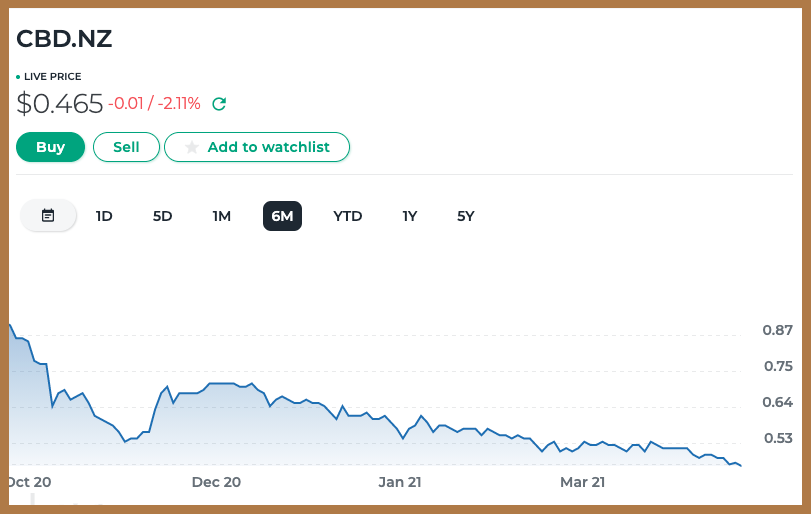
Shares represent a unit of ownership in a company, and thanks to sharemarkets like the NZX, everyday people can buy and sell shares in publicly listed companies. One of the first things you’ll probably notice about these companies trading on the market is their price. So how is this price determined, and what makes the price go up and down? This is a beginners guide to share prices, which will answer these questions and more!
This article covers:
1. What determines the share price?
2. What makes share prices go up and down?
3. Why didn’t my share price react to a particular event or news?
4. Is it better to buy cheaper or more expensive shares?
1. What determines the share price?
The sharemarket can be thought of as a place where buyers bid to buy shares at a certain price, and where sellers offer to sell a share at a certain price.
Example
Greg wants to buy 1,000 shares in Contact Energy, while Mary wants to sell 1,000 shares in Contact Energy. Given Contact Energy is a publicly listed company on the NZX, they can go to a NZX broker (like Sharesies or ASB Securities) to place an order to buy/sell Contact Energy shares.
The share price is determined based on the most recent price a company’s shares trade at (also known as the last price).
Example
Greg is willing buy 1,000 Contact Energy shares at a price of $7.50 per share, while Mary is willing to sell 1,000 Contact Energy shares at a price of $7.50 per share. Their orders match because they’re at the same price, so 1,000 Contact Energy shares get traded between Greg and Mary. The price of Contact Energy shares get set at $7.50.
If there is no one willing to buy and sell a company’s shares at the same price, then no trading occurs and the share price does not change.
Example
Greg wants to buy another 1,000 Contact Energy shares at a price of $7.50. There is no one wanting to sell Contact Energy shares. No shares are traded because Greg has no one to buy the shares from. The share price of Contact Energy remains at $7.50.
A while later Josh comes along who wants to sell 1,000 Contact Energy shares at a price of $7.60. Still no shares are traded between Greg and Josh, because their orders are at different prices. The share price of Contact Energy still remains at $7.50.
Share prices can change many times during the day based on the trading activity of a share.
Example
Greg finds that his order to buy 1,000 Contact Energy shares at $7.50 isn’t going through because there are no sellers at that price. He raises his bid price to $7.60. Now Greg’s buy order matches with Josh’s sell order, so 1,000 shares are traded between the two. Contact Energy’s share price is now $7.60.
The following chart shows the actual movement of Contact Energy’s share price throughout the day on Monday 19 April 2021.

2. What makes share prices go up and down?
A company’s share price is driven by supply and demand. Buyers want to buy shares at the lowest prices possible and sellers want to sell their shares at the highest price possible, but:
- If there is more demand than supply for a company’s shares (i.e. more buyers than sellers), then buyers have to bid for shares at higher prices in order to attract sellers, pushing the share price up.
- If there is more supply than demand (i.e. more sellers than buyers), sellers have to offer their shares at lower prices in order to attract buyers, pushing the price down.
So what could influence the supply and demand for a company’s share and cause the share price to rise or fall?
Examples of things that could increase demand, therefore increasing the share price:
- Internal factors like strong financial performance, winning the business of a major client, or the expansion into a new venture or product line.
- External factors like optimism over the economy, or optimism over the industry the company operates in.
For example, cancer diagnostic company Pacific Edge (PEB) announced earlier in April that one of their products would be covered by the largest healthcare insurance group in the US. Their share price shot up reflecting the fact the company’s shares are more attractive and in demand after winning the business of a major customer.

Examples of things that could increase supply, therefore decreasing the share price:
- Internal factors like a company’s falling customer numbers, or weak financial performance.
- External factors like a global pandemic, new legislation that could have a negative impact on the company, or general pessimism around the sharemarket.
For example, in October 2020 the New Zealand cannabis referendum failed to pass. Shares in medical cannabis company, Cannasouth (CBD), dropped significantly reflecting the fact that the company’s share are less attractive and in lower demand because their prospects to expand into recreational cannabis are now reduced.

Tip
If you’re unsure why a company’s share price has gone up or down, you can check a company’s market announcements to see if they’ve released a piece of news that’s caused the price movement. Announcements for NZX listed companies can be found on the NZX website.
There are many other reasons that could cause share prices to move, and sometimes there is no reason at all. It’s not always possible to pinpoint a reason for a share price’s rise or fall. That’s just the nature of shares – they are a relatively volatile asset class that constantly jumps up and down.
3. Why didn’t my share price react to a particular event or news?
In general a company’s share price reacts positively to good news and negatively to bad news. But there are times when the share price does not react at all. This is likely because that piece of news or event is already “priced in” to the shares, or in other words has already been factored in to the share price of a company.
For example, a company announces spectacular financial results that have greatly exceeded the previous year’s results. Most would expect the share price to go up, but what might cause the share price to stay the same or even go down in this case? The reason may be that:
- The company’s exceptional performance has already been priced in to the shares. The company may have provided an earnings upgrade (announcing to the market they expect their earnings to be higher than previously anticipated) prior to the announcement of their financial results, and the share price may already have risen to reflect the new earnings guidance.
- People were expecting (and therefore priced in) an even higher performance than what the company forecast. Even though the company’s results were exceptional, they still failed to meet everyone’s super high expectations.
- The company’s present financial results are great, but the company’s guidance or forecast for future results are underwhelming. Share prices are forward looking and will price in the potential future performance of a company.
Another example is that during the Christmas holidays more people will be travelling, so would you expect the Air New Zealand share price to go up during Christmas time as a result? The answer is no, because the fact that Christmas holidays leads to more customers is a well known event, given these holidays occur every year. The seasonal bump in bookings for Air New Zealand is already factored in to their share price. Share prices do not jump up just because we’re heading into a peak season, nor do they drop when entering a quiet season.
4. Is it better to buy cheaper or more expensive shares?
Let’s take two companies for example:
- Company A’s share price is $5
- Company B’s share price is $50
Company A is obviously cheaper in price, but we don’t have enough information to determine which is a better investment.
Firstly, share prices are a somewhat made up number. For example, Company C is worth $100 million and wants to list on the NZ sharemarket. Given shares represent a unit of ownership in a company, Company C could do one of the following:
- Split the company up into 100 million pieces, in which case Company C would be worth $1 per share.
- Split the company up into 1 million pieces, in which case Company C would be worth $100 per share
Regardless of whether the company is split up into “cheap” $1 shares or “expensive” $100 shares, neither option makes a difference and Company C is still worth $100 million (although the first option might trick beginners into thinking the company is cheaper). So given share prices alone are somewhat irrelevant in determining if a company is cheap or expensive, what concepts are more important to think about than price?
Percentage gain – Cheaper share prices mean you can buy a larger quantity of shares with the same amount of money. Is this a good thing to get more shares? No, because the quantity of shares you own doesn’t matter – it is the percentage gain that determines your returns.
Example
I invest $1,000 in Company A and $1,000 in Company B. This gives me:
– 200 shares in Company A
– 20 shares in Company B
Both companies’ share prices go up by 10%, so now Company A has a price of $5.50 per share, and Company B has a price of $55 per share. My investments are now worth:
– Company A: 200 shares x $5.50 = $1,100
– Company B: 20 shares x $55 = $1,100
Despite the lower share price of Company A enabling me to buy a larger quantity of shares compared with Company B, it is the percentage return that matters rather than the number of shares that I own.
Market capitalisation – Commonly known as market cap, this is an indication of the size of a company. Market cap is calculated by taking a company’s share price and multiplying it by the number of shares issued by the company.
Example
– Company A has 75 million shares outstanding
– Company B has 2 million shares outstanding
At a share price of $5 and $50 respectively, this give a market cap of:
– $375 million for Company A
– $100 million for Company B
Despite the smaller share price, Company A appears to be significantly larger than Company B. Looking at share price alone without additional context can be very misleading.
Price relative to intrinsic value – Price is different to value. Price only represents the last traded price of a company on the market, while intrinsic value represents how much the company is actually worth.
Unfortunately it’s very hard to determine a company’s intrinsic value – it’s only possible to estimate a company’s value based on analysis of the company and the environment it operates in. Because of this it’s possible for prices to deviate away from their true value. Shares can become overvalued (trading at a price above their intrinsic value) or undervalued (trading at a price lower than their intrinsic value). Therefore, rather than looking at a company’s share price alone, it’s better to look at a share price in relation to the company’s intrinsic value to determine whether it’s cheap or expensive.
Example
– Research analysts estimate that Company A’s intrinsic value is $4.50 per share. The company (trading at a price of $5) appears to be overvalued.
– Research analysts estimate that Company B’s intrinsic value is $60 per share. The company (trading at a price of $50) appears to be undervalued.
Despite Company A being cheaper in price, Company B appears to be cheaper in value as its share price is lower relative to its estimated intrinsic value.
Conclusion
Despite being one of the most visible elements of a company’s shares, price is one of the most misunderstood concepts, especially for beginners. This article has shown that:
- Share prices are set based on the price a company’s shares last traded at, and can change all the time in response to trading activity.
- Share prices go up and down based on supply and demand. There are many factors that can move share prices, but sometimes share prices can move for no particular reason at all.
- Share prices usually price in and reflect known facts or anticipated events that affect a company.
- Share prices are pretty much a made up number, and mean nothing without context. It’s better to look at share prices alongside metrics such as a company’s market cap and intrinsic value.
Follow Money King NZ
Join over 7,500 subscribers for more investing content:
Disclaimer
The content of this article is based on Money King NZ’s opinion and should not be considered financial advice. The information should never be used without first assessing your own personal and financial situation, and conducting your own research. You may wish to consult with an authorised financial adviser before making any investment decisions.